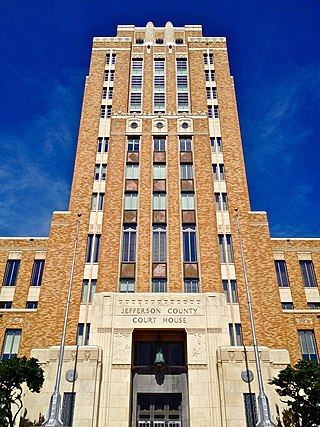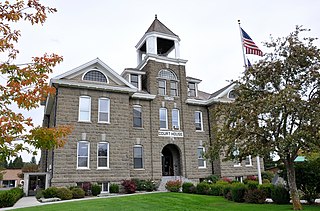
Berrien Springs is a village in Berrien County in the U.S. state of Michigan. The population was 1,800 at the time of the 2010 census. The village is located within Oronoko Charter Township.
The Berrien County Historical Association(BCHA) is a historical association located in Berrien Springs, Michigan. Established in 1968 as the Berrien County Historical Commission, the organization partners with Berrien County, Michigan to operate the History

The DeKalb County Courthouse is located in the county seat of DeKalb County, Illinois, U.S., the city of Sycamore. The Classical Revival structure sits on a square facing Illinois Route 64 as it passes through the city. The current courthouse was constructed in 1905 amid controversy over where the courthouse and thus, ultimately, the county seat would be located. The current building is the third structure to bear the name "DeKalb County Courthouse." DeKalb County's Courthouse still serves as the county's primary judicial center and is a contributing property to the Sycamore Historic District. The district joined the National Register of Historic Places in 1978. As the county's primary courthouse for over 100 years, the site has been host to many trials, including prominent murder cases.

The Ogle County Courthouse is a National Register of Historic Places listing in the Ogle County, Illinois, county seat of Oregon. The building stands on a public square in the city's downtown commercial district. The current structure was completed in 1891 and was preceded by two other buildings, one of which was destroyed by a group of outlaws. Following the destruction of the courthouse, the county was without a judicial building for a period during the 1840s. The Ogle County Courthouse was designed by Chicago architect George O. Garnsey in the Romanesque Revival style of architecture. The ridged roof is dominated by its wooden cupola which stands out at a distance.

The Geauga County Courthouse is located at 100 Short Court Street in Chardon, Ohio. The cornerstone was laid September 10, 1869 and construction was completed on August 20, 1870. The courthouse was listed on the National Register in 1974 as part of the Chardon Courthouse Square District.

The Courthouse of Crawford County, Ohio, is a landmark of the county seat, Bucyrus, Ohio. The courthouse was built in 1854 on East Mansfield Street by architect Harlan Jones and was added to the National Register of Historic Places on 1985-02-28 as a part of the Bucyrus Commercial Historic District.

The Jefferson County Courthouse in Beaumont, Texas is one of the tallest courthouses in the state, and is an excellent example of Art Deco architecture. Built in 1931, it is the fourth courthouse built in Jefferson County. It was designed by Fred Stone and Augustin Babin, and is thirteen stories high. In 1981, an annex was added to the west side of the courthouse.

The current Graham County Courthouse is a courthouse located at 800 W. Main St. in Safford, Arizona that is listed on the National Register of Historic Places. It is a two-story red brick building above a concrete foundation that includes a raised basement. The main part of the east-facing building is 83 feet (25 m) by 62 feet (19 m), and there is a one-story 17 feet (5.2 m) by 49 feet (15 m) north wing made of brick, and a small ell in the back.

The Humboldt County Courthouse is located in Dakota City, Iowa, United States, and dates from 1939. It was listed on the National Register of Historic Places in 2003 as a part of the PWA-Era County Courthouses of IA Multiple Properties Submission. The courthouse is the second building the county has used for court functions and county administration.

The Marshall County Courthouse is located in Marshalltown, Iowa, United States. The current building was completed in 1886 to replace an earlier building. The courthouse is a dominant landmark in downtown Marshalltown. It was individually listed on the National Register of Historic Places in 1972. In 2002 it was listed as a contributing property in the Marshalltown Downtown Historic District. It is the third building the county has used for a courthouse and county business.

The Wapello County Courthouse in Ottumwa, Iowa, United States, was built in 1894. It was listed on the National Register of Historic Places in 1981 as a part of the County Courthouses in Iowa Thematic Resource. The courthouse is the fourth building the county has used for court functions and county administration. It is part of the Central Park area, which includes: Ottumwa Public Library, Ottumwa City Hall, and St. Mary of the Visitation Catholic Church.

The Van Buren County Courthouse located in Keosauqua, Iowa, United States, was built in 1843. It was listed on the National Register of Historic Places in 1977 as a part of the County Courthouses in Iowa Thematic Resource. It is the only building the county has used as its courthouse, and it is the oldest courthouse in Iowa. In 1845 the courthouse served as the location for a trial resulting in the first death penalty in Iowa history.

The Pocahontas County Courthouse located in Pocahontas, Iowa, United States, was built in 1923. It was listed on the National Register of Historic Places in 1981 as a part of the County Courthouses in Iowa Thematic Resource. The courthouse is the third building the county has used for court functions and county administration.

The Menominee County Courthouse is a government building located on Tenth Avenue between Eighth and Tenth Streets in Menominee, Michigan. It was listed on the National Register of Historic Places in 1975 and designated a Michigan State Historic Site in 1974.

The Wallowa County Courthouse is the seat of government for Wallowa County in northeastern Oregon. The courthouse is located in Enterprise, Oregon. It was built in 1909–1910 using locally quarried stone. It is a massive High Victorian structure built of local Bowlby stone. The courthouse was listed on National Register of Historic Places in 2000. Today, the courthouse still houses Wallowa County government offices.

The Old McDonald County Courthouse is a National Register of Historic Places listed building located at 400 N. Main Street in Pineville, Missouri, the county seat of McDonald County, Missouri. It is situated in the center of Pineville's town square and served as the county's courthouse from 1871 until 1978, when a new courthouse was constructed two blocks north of the square. The structure underwent a significant restoration from 2010 to 2015 and is currently operated as a museum by the McDonald County Historical Society. It is designed in the American Foursquare style and was featured in the 1939 film Jesse James, which starred Tyrone Power as the titular outlaw and Henry Fonda as his brother Frank James. It is one of three sites in the county on the National Register of Historic Places, which also includes the Powell Bridge in the rural community of Powell, Missouri.

Treutlen County Courthouse is a historic courthouse building in Soperton, Georgia's Courthouse Square in Treutlen County, Georgia. It is a Neoclassical architecture building. It was built in 1920 at a cost of $20,000. The facade is made of brick with stone trim. A Doric portico extends from the main building. The interior has a cross plan, with four entrances. Double staircases lead to the courtroom. The judge's bench is framed by heavy wooden pediment and pilasters. It was added to the National Register of Historic Places on September 18, 1980.

The Old Berrien County Courthouse Complex, also known as the History Center at Courthouse Square, is a historic district located in Berrien Springs, Michigan. The complex is 1.6 acres and is home to five structures, two of which are the oldest of their kind in the state of Michigan. While the property and its buildings are owned by Berrien County and stewarded by the Berrien County Historical Association. While the historic 1839 Courthouse was added to the National Register of Historic Places in 1970, the BCHA resubmitted the application to include the remaining property added during the 1970s. The application was approve and the entire complex was added to the register 1982.

The Tuscola County Courthouse is a government building located at 440 North State Street in Caro, Michigan. It was listed on the National Register of Historic Places in 1996.

The Manitowoc County Courthouse is a three-story domed courthouse located in Manitowoc, Wisconsin. It houses the circuit court and government offices of Manitowoc County, Wisconsin. The building was listed on the National Register of Historic Places in 1981 and on the State Register of Historic Places in 1989 for its significance as a local example of Beaux-Arts and Neoclassical architecture. The courthouse is located in the Eighth Street Historic District.





















